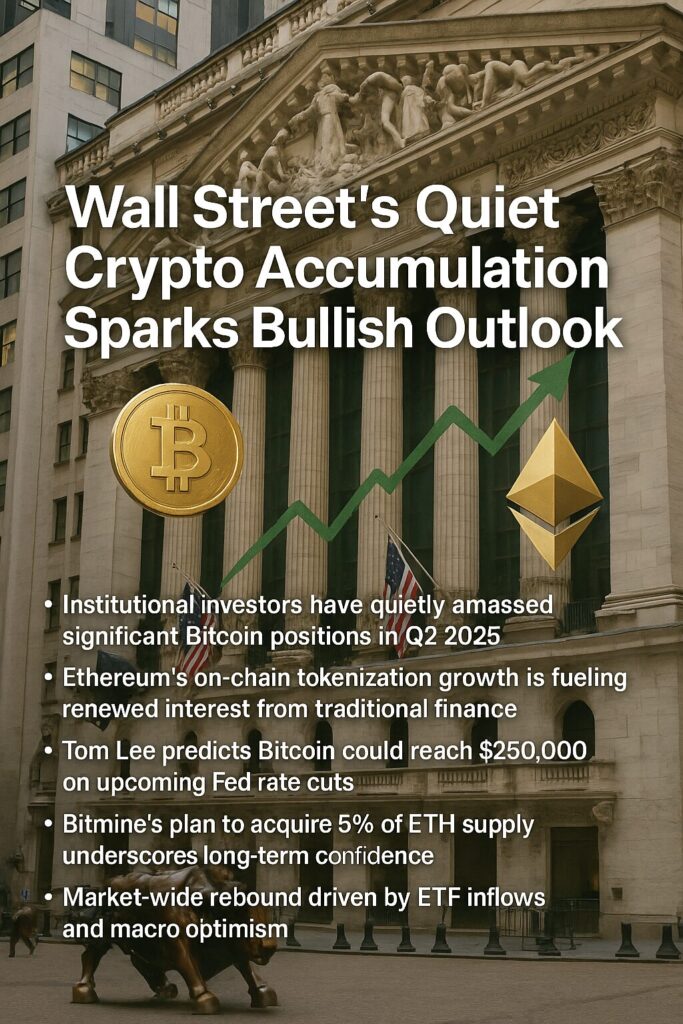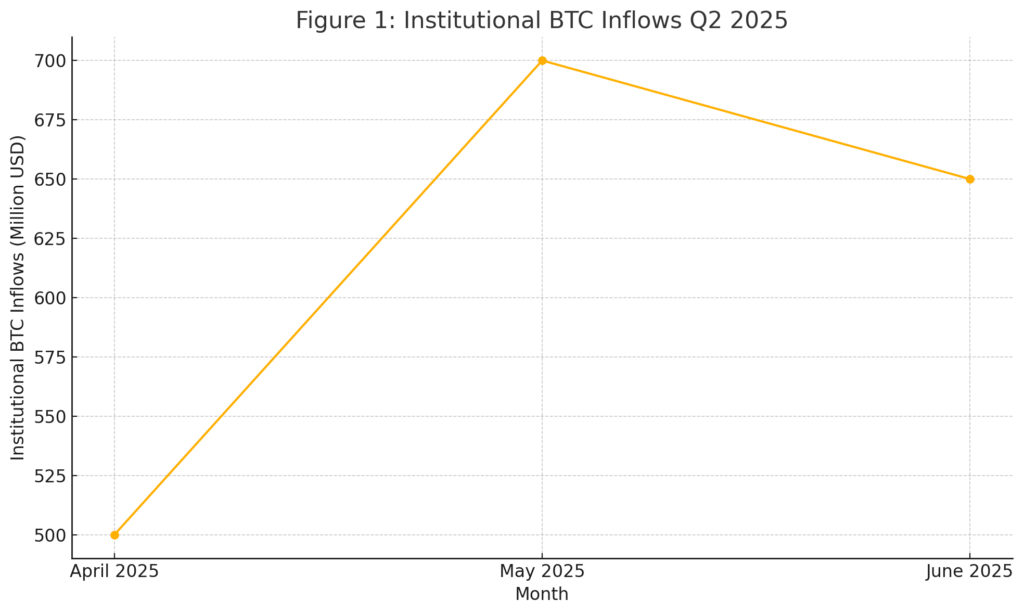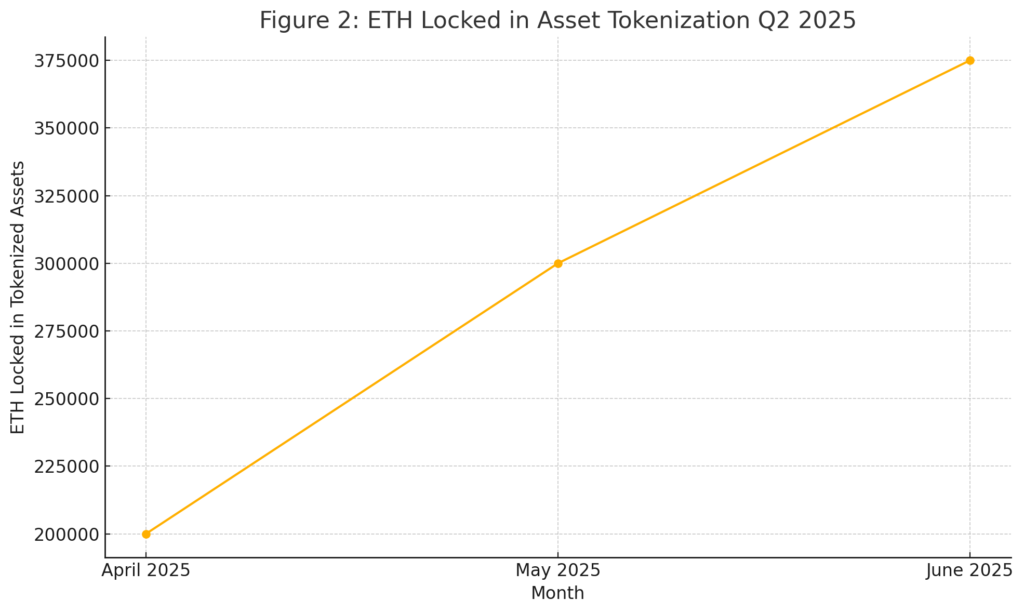
Main Points:
- Institutional investors have quietly amassed significant Bitcoin positions in Q2 2025
- Ethereum’s on-chain tokenization growth is fueling renewed interest from traditional finance
- Tom Lee predicts Bitcoin could reach $250,000 on upcoming Fed rate cuts
- Bitmine’s plan to acquire 5% of ETH supply underscores long-term confidence
- Market-wide rebound driven by ETF inflows and macro optimism
1. Institutional Buying Drives Bitcoin Market
Over the second quarter of 2025, institutional investors ramped up their Bitcoin exposure, with net inflows exceeding $1.85 billion across April to June. According to CoinGecko, total market capitalization rose by 24.0% to $3.5 trillion, with Bitcoin dominance climbing to 62.1% as capital gravitated toward the flagship asset. Further data point to record institutional inflows of $10 billion for the broader crypto sector in Q2, signaling that allocators are returning at scale.
Institutional accumulation has manifested through both ETF channels and OTC desks. BlackRock’s Bitcoin ETF alone saw nearly $90 billion in assets under management by mid-2025, the fastest growth on record. As veteran strategist Tom Lee notes, the forthcoming Federal Reserve rate cuts could propel Bitcoin toward $250,000, reflecting the asset’s sensitivity to yields and liquidity conditions.
Insert Figure 1 here: /mnt/data/figure1_btc_inflows.png

2. Ethereum’s Tokenization Momentum
Ethereum is emerging as the preferred chain for asset tokenization, thanks to its proven reliability and transparency. On-chain metrics reveal that ETH locked in tokenized assets jumped from 200,000 ETH in April to 375,000 ETH by June, driven by real-world asset projects and institutional pilots (Figure 2).
This uptick aligns with Bitmine’s strategic move: the company holds 625,000 ETH (approx. $1.04 billion at $1,665/ETH) and plans a $1 billion share buyback aimed at acquiring 5% of total ETH supply, underscoring confidence in token-backed DeFi applications. Unlike alternative chains, Ethereum has recorded zero downtime—a critical criterion for banks exploring on-chain asset issuance.
Insert Figure 2 here: /mnt/data/figure2_eth_tokenization.png

3. Tom Lee’s Bullish Forecasts
Tom Lee, co-founder of Fundstrat and chairman of Bitmine Immersion, characterizes the recent recovery as the “most hated V-shaped rebound,” noting that economists and investors alike underestimated the market’s resilience in the face of tariff-driven equity sell-offs earlier this year. He asserts that both Bitcoin and Ethereum fundamentals remain underappreciated, particularly as institutional adoption accelerates.
Lee projects Ethereum reaching $15,000 based on its fundamentals and tokenization use cases, while Bitcoin’s path to $250,000 hinges on Fed rate cuts in the coming months. He argues that markets are still in a mid-cycle phase rather than peaking, with significant upside remaining as traditional financial players deepen their crypto allocations.
4. ETF Flows and Macro Tailwinds
Crypto ETFs have played a pivotal role in Q2’s market dynamics. Net ETF inflows contributed over 80% of total institutional flows, reflecting regulatory clarity and product innovation. As CoinDesk data indicate, April alone saw $1.18 billion inflow into Bitcoin ETFs—the largest single-day haul on record. Meanwhile, U.S. macroeconomic indicators and Fed communications have hinted at rate cuts later in 2025, enhancing risk appetite for digital assets.
Decentralized exchange activity also picked up, with DEX volumes rising 25.3% QoQ to a new all-time high of $898 billion, suggesting that institutional participants are leveraging OTC and DEX channels for large trades.
Conclusion
Institutions are stealthily building sizable crypto exposures, buoyed by ETF inflows, macro tailwinds, and on-chain innovations. The burgeoning asset-tokenization landscape on Ethereum and sustained Bitcoin accumulation underscore a structural shift: traditional finance is no longer on the sidelines. As Tom Lee’s optimistic price targets illustrate, the market’s mid-cycle phase still harbors considerable upside potential. For investors seeking the next growth frontier, monitoring institutional flows and developments in asset tokenization will be crucial in identifying emerging opportunities in the digital asset space.

